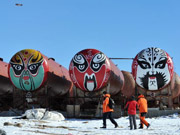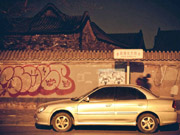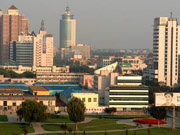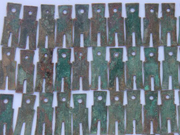 |
| Consumers wait outside a branded store on Nanjing Road. W. yesterday. (Photo/Shanghai Daily) |
AS international fast fashion retailers vie for a chunk of the Chinese market, they have also been frequently troubled by quality problems. But consumers have largely shrugged off those concerns, preferring to focus on the latest fashion trend rather than quality.
Poor color fastness, a high pH index, unmatched fiber content and excessive formaldehyde are the most common problems regularly cited by quality watchdogs.
Fast fashions brands are known for their current trends, fast upgrade of products, quick manufacturing process and affordable prices.
But such swiftness is also becoming a double-edged sword, experts warned.
“Some fast fashion brands cut the production and sales cycle to meet the rising demand, leading to oversight in supervision and quality problems,” said Zhang Dezhi, director of the consumption guidance department of China Consumers’ Association.
At the same time, the frequent change of fabric suppliers and the retailers’ pursuit of lower processing cost hurts quality, Zhang said. In their pursuit to be out in the market quickly and cut costs, some of them loosen control over materials and processing process.
“Due to the rising procurement cost in China, fast fashion retailers usually make procurement overseas in countries like Vietnam, and their lack of control of raw materials is the root cause of substandard products,” said Wang Weiqing, director of the State Supervision and Inspection Center for Garment Quality (Shanghai).
Poor color fastness is the most common problem among the brands, she said.
Brilliant color is a feature of fast fashion clothing, while short dying process leads to early color fading, the association said.
Most fast fashion retailers use original equipment manufacturer, or OEM model, which refers to manufacturing products or components that are purchased by another company and retailed under that purchasing company’s brand name.
The association called on fast fashion retailers to regulate the purchase of raw materials, establish stable supplier system and step up quality tests, which are skipped to save time.
Adding testing procedure will certainly prolong the process of products on the shelves, but it will also help in building the consumers’ trust in their quality, the association said.
In designing, companies can be quick, but strict quality control should always be the key.
Rapid expansion
The brand expansion of fast fashion retailers has been very rapid in China, and they are competing more aggressively at shopping centers across the country.
Fast fashion retailers are now exploring markets in second and third-tier Chinese cities. In first-tier cities, they are changing direction by tapping a diversified product line like home textiles and children’s products, said Chen Lilin, director of retail department of RET Property Consultants.
Last year, Zara opened 22 new outlets in China, exceeding its target and bringing the total number of its stores in China until the end of last year to 142, according to global independent property consultant Knight Frank. H&M opened 49 new stores last year. It now has more than 100 stores in China.
Industry sources said the global purchase and manufacturing strategy of fast fashion brands and different standards of fabrics in China and overseas have also contributed to quality loss. Besides, the penalty is not hefty enough. In most cases, substandard products are ordered to be taken off shelves and the retailers are just told to rectify them.
Reacting to the issue, Spain’s Inditex, which owns the Zara brand, said quality was its top priority and its quality control system covers every procedure from design to production. It said it provides training to suppliers and conducts strict tests on samples randomly drawn.
H&M said it had addressed the problem about wrong labeling and had no other issues.
Design over quality
However, the problems have not hurt the sales of the brands, with buyers more concerned about the chic design, price and brand than quality.
At a Zara outlet on Nanjing Road W., Angela Tang, a 27-year-old white collar worker, said she only cared about the design and did not worry about the quality. “You can not expect very high quality for that price,” she said. She wears the clothes for less than two years, and her only concern was that it should look good. “Even if I know about their quality problems, I will still buy them because they are the latest fashion trend,” she said.
Chen Min, 50, said she usually checks the material of the trousers. “I pay more attention to the fabric when I buy trousers here, but I do not expect them to be a high-end material for the price it is sold,” she said.

 800-year-old ancient village in Shanxi
800-year-old ancient village in Shanxi A glimpse of China's Zhongshan station in Antarctica
A glimpse of China's Zhongshan station in Antarctica Female marines receive tactical training in NW China
Female marines receive tactical training in NW China Shanghai women fall in love with Aerial Yoga
Shanghai women fall in love with Aerial Yoga This is Beijing – Nanluoguxiang
This is Beijing – Nanluoguxiang Old photos of Anti-Japanese War (1937-1945)
Old photos of Anti-Japanese War (1937-1945) Top 10 cities for falling house prices in January
Top 10 cities for falling house prices in January Top 10 richest real estate tycoons: Hurun
Top 10 richest real estate tycoons: Hurun Large numbers of ancient coins excavated in Inner Mongolia
Large numbers of ancient coins excavated in Inner Mongolia British WWII veteran: I can't forgive Japan
British WWII veteran: I can't forgive Japan Top 10 brands that win rich women's hearts
Top 10 brands that win rich women's hearts Memorizing the Flying Tigers
Memorizing the Flying Tigers The Chinese Dream: the Chinese Spirit and the Chinese Way
The Chinese Dream: the Chinese Spirit and the Chinese Way
Day|Week|Month